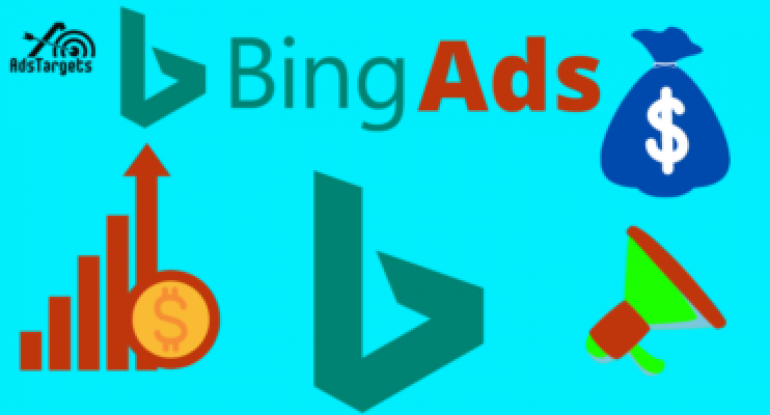Updated 02/05/2025
While Google, with a global market share of over 90%, is clearly the most important search engine, its competitor Bing should not be underestimated.
If you want to try to reach your target as much as possible, in many cases it is also advisable to advertise on the Microsoft search engine.
Of course, when it comes to search engine advertising (SEA), you rely on Google AdWords first, but Bing ads are no exception as they further draw potential customers’ attention to you and your business.
Table of Contents
ToggleWhat is Bing Ads?
Microsoft Bing Ads is the advertising program of the Bing search engine. Its great advantage is that the search engine is part of Yahoo! Bing Network. For this reason, Microsoft’s solution ads also appear in the search results of the Yahoo! search engine

Initially marketed as adCenter, Bing Ads has meanwhile caught up with its competitor Google in terms of functionality.
The system is based on Pay per click (PPC), just like Google’s. This means that advertisers only pay when users actually click on the ad but not when the website shows an ad.
Bing Ads distinguishes between campaigns, ad groups, ads and keywords, structured according to a hierarchical order: for example, the campaign is a collection of ad groups.
Basically These Are Practical Containers for your Ads and keywords.
#1 Campaign
When starting a campaign with Bing Ads, first of all you need to consider what its primary focus should be.
For example, do you have a new product in your assortment or do you want to focus on a special discount campaign? Define your campaign target and adjust your ads accordingly.
#2 Ad group
Ad groups are designed to manage ads. In groups, keywords are established and suitable ads created. In this way, you create different variants of ads with the same keywords.
#3 Ad
Your ad uses those keywords that you set yourself in the ad group. Consequently, the advertisements within an ad group all have the same priority and differ from each other especially in detail.
#4 Keyword
With your ad groups or rather with ads within them, you can bid in auctions to get advertising space for certain keywords.
Within your campaign, you determine which keywords are important for your marketing.
Subscription to Bing ADS
If you would like to sign up for Bing Ads, the sign up form asks first to create an account with MSN, in case you have no connection to the Microsoft network.
On the next page, enter the usual information for creating your account: name, address and (as you intend to invest money in marketing campaigns) your preferred currency.
Already in the next step you can start creating an advertising campaign if you wish. In fact, you also have the possibility to import an existing campaign from Google AdWords or alternatively to skip this step and finish the registration.
In the last phase (“Proceed with activation”) Bing requests the payment details, but even this step can be ignored for the moment. Registration is now complete.
Practical Tips for Winning with Bing Ads
Bing Ads gives you access to a valuable audience, especially older users, desktop users, and professionals using Microsoft tools. To run successful campaigns on Bing, follow these proven tips:
#1. Set Clear Goals – Choose specific objectives like lead generation, product sales, or website traffic so you can measure success accurately.
#2. Use Bing’s Import Tool Wisely – Import your top-performing Google Ads campaigns, then tweak them to match Bing’s search behavior and audience intent.
#3. Target High-Intent Keywords – Focus on exact match and phrase match keywords to drive more qualified traffic and avoid wasted clicks.
#4. Optimize for Desktop Users – Since a large portion of Bing users are on desktop, create desktop-friendly landing pages with fast load times and clear CTAs.
#5. Write Direct, Benefit-Driven Ads – Use strong headlines, clear value propositions, and calls to action like “Shop Now,” “Get Free Quote,” or “Book Today.”
#6. Use Ad Extensions – Add site links, callouts, and structured snippets to increase visibility and improve CTR without raising costs.
#7. Install the UET Tag – Set up Bing’s Universal Event Tracking to track conversions and retarget visitors based on their actions.
#8. Test and Optimize Weekly – Run A/B tests on headlines, bids, and keywords. Pause underperforming ads and shift budget to top performers.
#9. Leverage Location and Device Adjustments – Increase bids for high-performing regions or devices to boost ROI.
#10. Take Advantage of Lower CPCs – Bing’s competition is lighter. You can often get premium ad positions at a lower cost than Google Ads.
Bottom line: Bing Ads isn’t just a backup to Google—it’s a powerful channel on its own. If you optimize for its strengths, you’ll reach an untapped audience and stretch your ad budget further.
Bing features: Types of Advertising Compared
Search campaigns consist of advertisements that appear in a search query on Bing. The search engine displays ads above the organic search results or in a sidebar next to the results.
To do this, Bing specifies positions 1 to 9: the first 4 are located directly under the search bar (mainline) and the rest takes place in the sidebar.
In addition, it is possible to create shopping campaigns for e-commerce managers.
The system displays your products directly in the search results, including image and price.
To do this you first need to set up the Bing Webmaster tools and set up an account in the Merchant Center. Then thanks to the eye-catching advertisements of your products you will attract further attention.
Search Engine Marketing: The Bing Ads Tutorial
If you create a new campaign in the Bing Ads summary, the web service asks you for your goals first – for example, would you like to generate more traffic or more conversions?
Depending on your choice, Microsoft’s solution offers you suitable features. And, no matter which option you prefer, beyond these proposals, you still have the full range of Bing Ads features available.
The question about the objectives of the campaign is asked solely for the purpose of offering you help to better orient yourself.
#1. Project your campaign
First, give your campaign a name: choose one that is clear and unambiguous, so that when you are managing multiple campaigns at the same time you will not confuse it but you will know immediately what it is.
Then set the amount of the daily budget for your advertising strategy on Bing Ads.
How much do you want to invest in your campaign? In addition, you have the ability to determine whether Bing should distribute the budget equally throughout the day or whether it should spend it as soon as possible.
The standard option, ie distribution over the whole day, is the ideal choice for most lenses.
There is also a particular feature, the “shared budget”: this function allows multiple campaigns to share the same budget. Clearly this is only possible when you have already started further campaigns.
Then you have to choose the language and place. First of all, set the language in which you write your ad, by doing so you have already circumscribed your target: for example, only Italian-speaking users will see the ads in Italian.
The choice of place is done in a similar way: however, here you must specify whether the action should be shown to users who live in the established place or whether it is also visible to users who search for the place in the search engine. This differentiation helps to reduce dispersions.
#2. Determine ad group and keywords
In the next step, you determine your ad groups and keywords – a campaign consists of multiple ad groups.
Thanks to the various groups you can make sure that your ads are shown for different search terms: however, for this to work, you must also assign different keywords to the different groups.
It is recommended that at least 20 keywords be entered for each ad group. These keywords are of fundamental importance for the success of your campaign: only if a user enters one of the keywords you set, then there is the likelihood that Bing will show your ads.
For this reason, Bing Ads also helps you in finding the correct terms: at this point, you just have to enter the URL of your website and a product you want to promote.
The system analyzes both the contents of your page and the type of product or service advertised and on this basis then proposes a series of keywords.
To ensure that you have as much control as possible over what conditions under which your ad is shown, Bing offers you a useful tool: it is the Broad Match Modifier.
Thanks to this tool you can decide the degree of correspondence between the user’s entry and the keywords you have defined so that the ad is shown:
- Example_Keyword: If you enter a keyword without the operators, a rough match is enough to activate the ads. This means that Bing also considers integrating keywords into other phrases.
- +Example_Keyword: With the symbol of “+” you establish that the variants of the word also apply (for example the plural form).
- “Example_Keyword”: If you put the keyword in quotation marks it means that you are looking for a precise match of the expression, so the words must appear in the exact order you have indicated in order for the search engine users to be able to see your ad. However, the researcher also has the possibility to add other words before or after the sentence.
- [Example_Keyword]: Using the square brackets you establish an exact match of the keyword phrase as an activation criterion. The user must enter the keyword in the search bar exactly like this for Bing to show your ad.
#3. The ad
Once you have selected all the desired keywords and created a sufficient number of ad groups, you can proceed to the next step: create your ads.
Basically an ad on Bing consists of the title, ad text, and the URL you want to forward it to. The title consists of two parts separated by a hyphen, each of which has a maximum of 30 characters available.
It makes sense to include one of the most important keywords in the title. Instead, the text has a maximum length of 80 characters.
In general, the following rule applies to both: the content must be relevant to readers and provide useful information about your offer.
A special feature is the dynamic text that you can insert in the headlines and ad texts: it is in fact a placeholder that Bing compiles according to the user’s search query. You have two different types of placeholders available:
- {Example_Keyword}
If you use this placeholder, the system will insert in the text the keyword that the user is looking for at that moment. In this way, at best the user is notified of the relevance of your ad.
- {Param1} / {param2} / {} param3
Bing allows you to enter up to three user-defined texts. You can assign keywords to these. For example, it is possible to draw attention to different discounts applied to various products depending on what the user is looking for.
Enter two different links to your website: the final URL and the so-called path.

The first is the URL that leads directly to the correct web page, for example, the product page. However, it is linked via the section title.
The user, on the other hand, sees the path as part of the ad in its exact wording: it should therefore be more user-friendly than the real URL.
To make it clear to the user what this is, add up to two subdirectories in the path.
This way you can make it clear to future visitors to your website which subcategory the URBudget
With Bing, you also have the opportunity to add value to your advertising with the help of extensions: these have the task of providing additional information for users and thus encouraging them to click on your ad.
#4. Budget
Before activating your campaign, there is still one last step in which you establish the financial plan.
Even if you have already entered your budget in the first step, you now have another opportunity to change it.
Then comes the bidding strategy: just like with Google AdWords, even with Bing Ads, in addition to the ability to buy ads, there is also the ability to win them through auctions.
Therefore, the cost of ads on Bing Ads strongly depends on the choice of keywords and their value in the market, given that different companies want to present their ads for a particular keyword.
When a user enters a search term on Bing, several ads compete for sponsored space on search results.
Within milliseconds, the offers are compared with each other, after which the winners are determined.

As a Bing Ads user, you decide whether to submit a particular offer or let Bing adjust it.
If you choose the second option, Bing can increase the bid by up to 30% to increase the probability of closing.
However, it is first of all necessary to set up a closure tracking system so that Bing knows what goals you are pursuing and if you will reach them: to do this you need to include a UET tag on your website so that Bing can track conversions.
You always have to set bids for an ad group and then bid on clicks: you only pay for the ad when a user actually clicks on it, which is why we talk about Pay per click (PPC).
While you are adjusting your bid amount, Bing presents you with some estimates for your ad:
How many clicks can you get with your bid?
How many people will see your ad?
What are the monthly costs for this ad group with the settings selected?
And finally: in which position in the search results will you be most likely to see your ad? Adjust the value until you are satisfied with the result.
Remember, these are only estimated results – even Bing cannot predict who will compete with you in an auction.
Bing Ads Editor
Thanks to the Bing Ads Editor software, you can plan and configure your campaigns and ads even offline. Instead of using a browser, you can create your own advertising campaign with the free editor.
To do this, download the installation file (available for Mac and Windows) and connect to your existing Bing Ads account, after which the software will upload your campaigns directly from the Internet.
The design and functionality of the desktop application are not very different from those of the browser.
The editor makes it particularly easy to make multiple edits simultaneously and manage different campaigns and ad groups simultaneously.
As this is an offline application, you shouldn’t forget to put all your changes online.
Costs
With both advertising options, you determine the budget and the offers yourself, so a direct cost comparison is not possible.
As for the auction system, Bing’s low market share could be seen as an advantage: while on the basis of a keyword Google responds by offering countless companies, competition on Bing is much tighter.
Therefore winning keyword bids on Bing should be much lower than on Google.
Bing Ads Campaign Tutorial
Conclusion
Bing Ads may not have the dominance of Google Ads, but it offers a powerful, often underutilized platform that can effectively reach unique audiences at a potentially lower cost-per-click. With its seamless integration across the Yahoo! Bing Network, flexible ad formats, detailed keyword targeting, and user-friendly campaign structure, Bing Ads presents a valuable opportunity for businesses aiming to diversify their digital marketing strategy. Whether you’re looking to increase traffic, drive conversions, or retarget warm leads, this platform gives you the tools to tailor your message and track results with precision. By mastering the setup, ad types, and budget planning—along with utilizing keyword modifiers and performance tracking, you can unlock a cost-effective channel that complements your overall PPC strategy.








